Laboratory Testing Services Manual - Guidelines for Specimen Shipping and Mailing
This page provides information about Laboratory Testing Services Manual - Guidelines for Specimen Shipping and Mailing .
Laboratory Testing Services Manual - Introduction
- Laboratory Testing Services Manual - Laboratory Tests for Diseases and Agents
- Laboratory Testing Services Manual - Specimen Receiving, Lab Hours, Holidays
- Laboratory Testing Services Manual - Guidelines for Specimen Shipping and Mailing
- Laboratory Testing Services Manual - Specimen Collection and Submission Form Guidance
- Laboratory Testing Services Manual - Forms and Laboratory Fee Schedule
- Laboratory Testing Services Manual - Local Health Department Laboratories
Get in Touch
Laboratory Testing Services Manual - Guidelines for Specimen Shipping and Mailing
Introduction | Changes to Lab Testing Services Manual | Contact Information | Local Health Department Labs | Specimen Collection and Submission | Specimen Shipping, Mailing | Specimen Receiving, Lab Hours | Lab Tests | Forms, Fee Schedule
This manual was developed to help submitters meet the DSHS Laboratory specimen submission process requirements. It will also guide submitters in avoiding the most common reasons specimens are identified as unsatisfactory for testing, or unsat by the Laboratory.
Quick reference DSHS specimen submission job aids are available here.
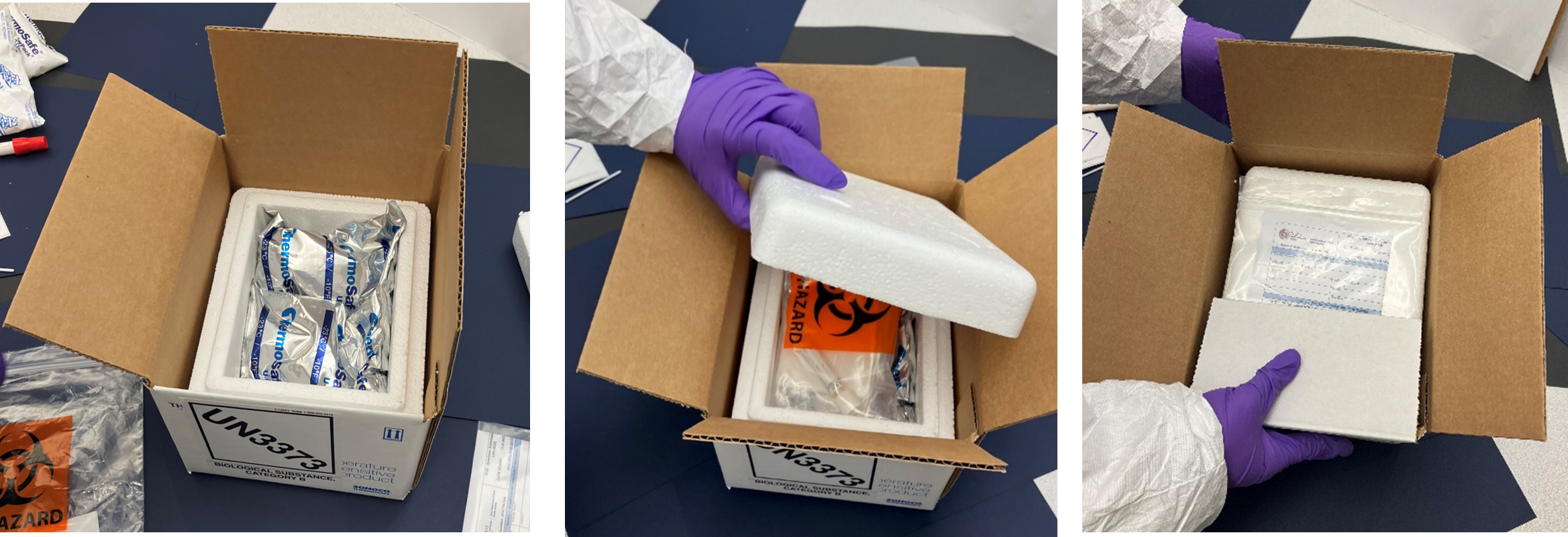
Note:
- The shipping guidance provided on these pages is not a substitute for the required packing and shipping training submitters must complete. The DSHS Laboratory is not responsible for training submitter personnel or improperly shipped specimens.
- Refer to sections Packaging and Labeling of Category A Infectious Substances and Packaging and Labeling of Category B Infectious Substances for more details on available training resources.
- External web links are included for informational purposes only. These links do not represent an endorsement by the Texas DSHS of the goods and/or services provided by these entities. These sites may not be accessible to people with disabilities.
All submitters are required to submit the correct specimens in the best conditions possible. Testing cannot be performed on inadequate or substandard specimens.
Please submit specimens with care. Remember that every specimen has a patient behind it!
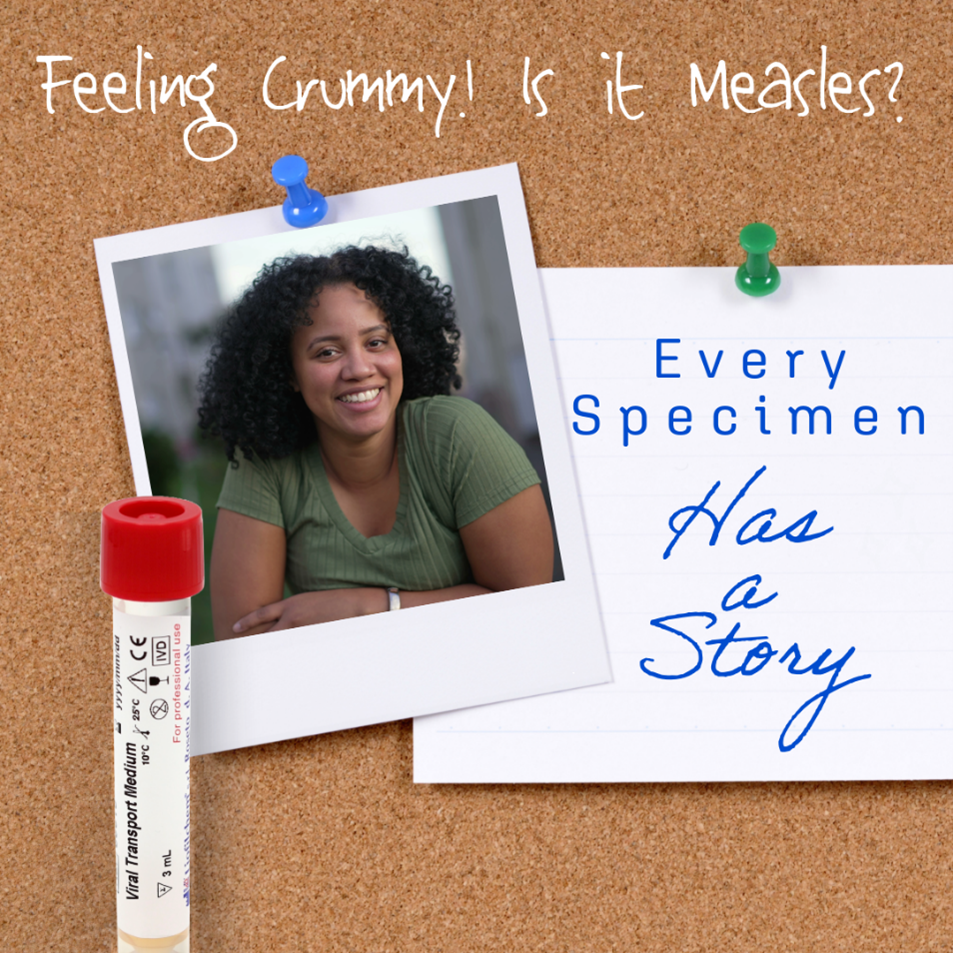
The DSHS Laboratory enforces the principles of Good Laboratory Practices (GLP). These practices are a defined set of rules and criteria that ensure the reliability, reproducibility, quality, and integrity of the tests we carry out. GLP informs the Laboratory’s policies, licensure, and mission. Testing services may be withdrawn from a submitter by the Laboratory if that submitter misuses the service or improperly submits specimens.
DSHS Laboratory submitters are required to:
- Determine the mode of transportation to ship specimen(s) to the Laboratory. The federal transportation rules that apply depend on the mode of transport used (road, rail, or air freight, for example).
- Determine the correct classification of specimens before submission. The classification of the specimen as either an “infectious substance”, “biological substance”, or as “exempt”, determines what shipping service can be used and how it needs to be packaged.
- Be trained and maintain certification if packing and shipping infectious substances. Without exception, anyone who packs and ships specimens classified as Infectious Substances must complete the appropriate training and maintain their certification(s) for review. Refer to the section Training Required for Submitters of Infectious Substances.
- Pack specimens according to their classification. Submitters need to review and be knowledgeable of the federal regulatory standards for the transport of biological and infectious specimens by road, rail, and air.
- Ship specimens according to all safety and labeling regulations. Submitters need to review and be knowledgeable of the federal regulatory standards for the transport of biological and infectious specimens.
- Ensure ALL required patient information and documentation is provided. Specimens must arrive with the required documentation. Refer to the Guidelines for Specimen Collection and Submission sections Required Fields on Submission Forms; Sample Submission Form Showing Required Fields and Providing Patient Information on Specimens and Submission Forms to identify the required patient and submission form information.
- Ensure specimens are shipped to the Laboratory promptly. Delays in shipping may result in specimens being too old to test when they arrive.
- Store and ship specimens at the required temperatures. Temperature-sensitive specimens that arrive at the Laboratory out of temperature range cannot be tested and are rejected.
- Ensure transport media and collection kits are not expired. Specimens that arrive at the Laboratory on expired media cannot be tested. Check the expiration dates on specimen collection tubes, kits, and transport media before using them.
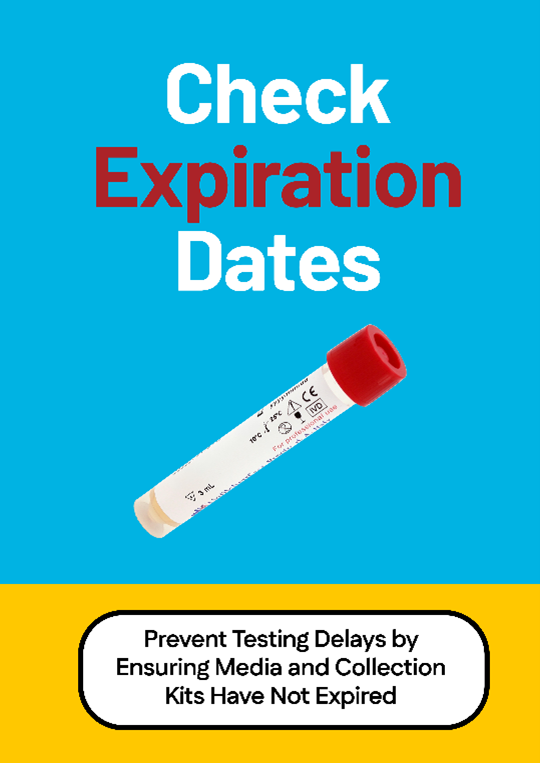
- Ship Specimens Appropriately. Biological specimens could pose a health hazard if not shipped correctly. Specimens must be shipped according to the applicable shipping regulations.
- Submitters Must Confirm the Classification of the Specimen Before Shipping to the Laboratory. Personnel who handle, package, and ship specimens classified as infectious substances must be properly trained. Refer to Packing Instructions 620 for Category A Infectious Substances and Packing Instructions 650 for Category B Biological Substances. Also: IATA - DG Documentation.
- Store and Ship Specimens at the Correct Temperature. Temperature-sensitive specimens that arrive at the Laboratory out of temperature range are rejected.
Ship cold or frozen specimens overnight. Pack specimens that need to remain cold or frozen with adequate amounts of cold packs or dry ice. A single frozen ice pack is usually not enough to keep specimens cold during shipping. For more information on shipping specimens to the Laboratory, refer to the Guidelines for Specimen Shipping and Mailing. - Specimens Must be Labeled Correctly. Shipping services may reject or delay any specimen package that is incorrectly labeled. Missing documents or an incorrect Laboratory address can also cause delays.
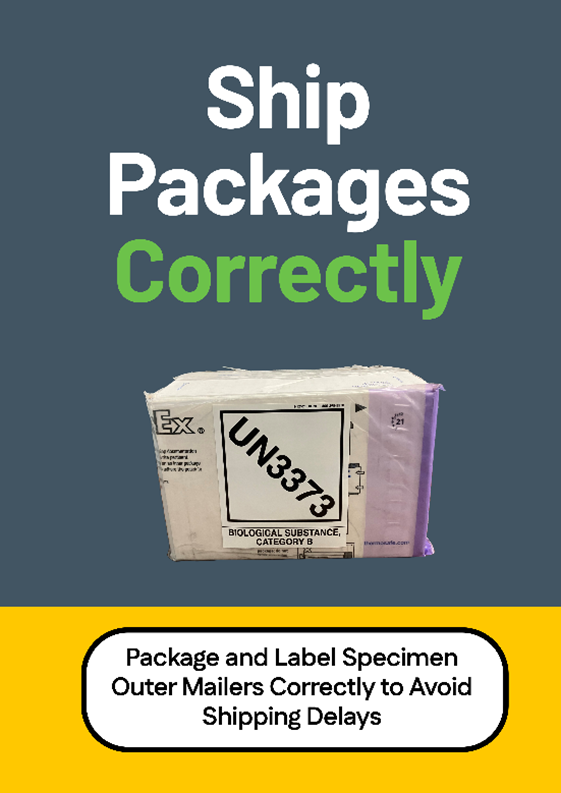
Shipping regulations and training requirements help ensure infectious substances are shipped safely. Anybody, including public health and commercial laboratory staff, who handles, packs, or prepares infectious substances for shipping must be trained on how to handle and transport these substances. Failure to pack and ship infectious substances properly breaks federal law. Submitters who do not follow these requirements could face fines and possibly imprisonment.
The U.S. Department of Transport (DOT) and Pipeline and Hazardous Materials Safety Administration (PMHSA) rules that apply to the transport of infectious substances are found in the Hazardous Materials Regulations (HMR).
Training Requirements for Shipping Category A Infectious Substances
Anybody who ships specimens classified as Infectious Substances, Category A, is required to complete training every two years OR if regulations change and to maintain their certification for inspection. The Category A shipping process can include packaging, preparing the paperwork, assembling the package, labeling, or any other activity associated with transport.
Shippers of Category A infectious substances are bound by regulations from several international and national agencies. These regulations have been harmonized across agencies and are in place to ensure infectious substances are transported as safely as possible.
International Air Transport Association (IATA) training resources for shipping Category A infectious substances by air include:
IATA - Infectious Substances Shipping Guidelines Course (partner-taught or self-study).
Training Requirements for Shipping Category B Infectious Substances
Per the Code of Federal Regulations, 49 CFR §173.199: Handling and Transporting Infectious Substances, personnel responsible for handling and packing specimens classified as Category B infectious substances must be trained on correct specimen handling and correct submission protocols. “Personnel” includes anyone who handles or prepares specimens for transport, procures specimen carriers, and or transports specimens.
In addition, per IATA regulations, a dangerous goods certificate of training is required for any person who submits dangerous goods to a public carrier for transportation.
The information about training resources on these pages is not a substitute for the required training submitters must complete. The DSHS Laboratory is not responsible for training submitter personnel or for improperly shipped specimens.
- The DSHS cannot and does not endorse or recommend a specific vendor for training services.
- The inclusion of external web links is for informational purposes only. The links do not represent an endorsement by the Texas Department of State Health Services of the goods and/or services provided by these entities. These external sites may also not be accessible to people with disabilities.
The DSHS Emergency Preparedness Branch offers comprehensive, in-person shipping training for Category A, Category B, and exempt human specimens. NOTE: DSHS online class access requires a Media Lab account; set-up instructions are found in the link https://www.dshs.texas.gov/lab/eprTraining.shtm.
U.S. Pipeline and Hazardous Materials Safety Administration (PHMSA): Hazardous Goods Handling
Hazardous Materials One-Day Workshops | PHMSA (dot.gov)
Additional resources on requirements for the handling and shipping of Category B infectious substances include:
U.S. Department of Transport (DOT)
International Air Transport Association (IATA)
- Dangerous Goods Regulations, 66th Edition.
U.S. Pipeline and Hazardous Materials Safety Administration (PHMSA)
PHMSA’s Check the Box Initiative (General information about shipping hazardous materials; targeted toward the general public.)
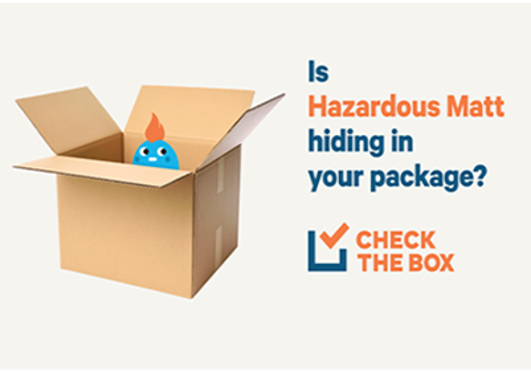
Hazardous Matt is the brand ambassador for PHMSA's Check the Box initiative, which aims to promote public awareness of the need for safer shipping of hazardous material. Posters, fact sheets, brochures, and videos are available at the PHMSA's Check the Box website Source: U.S. Dot PHMSA.
The Category A and Category B Infectious Substance classification criteria for transporting biological specimens were developed and standardized to help clarify labeling and shipping requirements and to improve safety by increasing rules compliance. These criteria are consistent with international standards.
Details on the types of specimens classified as Category A and Category B Biological Substances may be found at USDOT PHMSA.
Several specimens tested at the DSHS Laboratory are classified as “exempt specimens”. These specimens can be reasonably expected to not pose a health risk, so they do not quality as infectious substances. Newborn screening (NBS) cards, for example, are exempt specimens. They have dried bloodspots on them and can be reasonably expected to not contain microbial pathogens.
In specific cases, specimens classified as Category B do not require labeling when being shipped by certain contracted courier services. These qualify as “exempt specimens”.
Any material defined as an “Exempt human specimen” or “Exempt animal specimen” may be shipped in a packing system similar to those required for infectious substances, without being subject to infectious substance regulations. The term “Exempt Human Specimen” or “Exempt Animal Specimen” must appear on the package.
There is no limit on the number of exempt human or animal specimens that may be carried in a mail package on any mode of transport. Submission and shipping guidelines for NBS specimens can be found at DSHS Newborn Screening Specimen Collection Requirements (texas.gov).
All specimens classified as Infectious Substances that are submitted to the Laboratory must be packaged in a way that minimizes the likelihood of spills and breakages. Correctly packaged specimens protect couriers, the general public, Laboratory staff, and others who may come in contact with the package.
- “Category B Substance”: A human or animal material known or reasonably expected to contain a pathogen, including but not limited to stool, sputum, blood and its components, tissue, and tissue fluids being transported for medical or veterinary use, diagnostic, or investigational purposes. All packages must be marked “Biological Substance, Category B, UN3373”.
- Required Packaging: Specimens must be triple packaged in a way that withstands shocks, pressure changes, leaks, and other conditions related to ordinary handling in transit.
- Absorbent Material: A material such as cotton balls, cellulose wadding, or paper towels that can soak up the entire contents of the specimen(s) in the primary container(s) should they break or leak.
- Primary Receptacle (Container): Swab collection/transport tubes are primary receptacles. A primary receptacle must be:
- leakproof (for liquids) or sift-proof (for solids).
- able to maintain its shape during shipping.
For shipping by air, single primary receptacles must:
- be able to withstand a pressure differential of no less than 95 kPa(0.95 bar, 14 psi)(Categories A and B).
- not contain more than 34 fluid ounces (1 L) of liquid specimen or 8.8 pounds (4 Kg) of solid specimen (Category B).
For more details, see Package Criteria 49 CFR § 173.199 and Packing Instructions IATA/ICAO PI 650 (for Category B) and 49 CFR § 173.196 and IATA/ICAO PI 620 (for Category A).
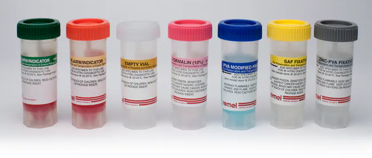
A selection of stool collection containers; examples of primary receptacles. Image Source: Remel.com
Secondary Container:
- Must be leakproof if carrying a liquid and sift proof if carrying a solid.
- Must be constructed of durable material and have a means of being sealed securely.
- Must also contain sufficient absorbent materials to absorb the entire contents of the primary container in case of breakage or leakage.
- Must be labeled with the international biohazard symbol, as shown in the photo. Biohazard symbols for Category B must not be affixed to the outer mailer.
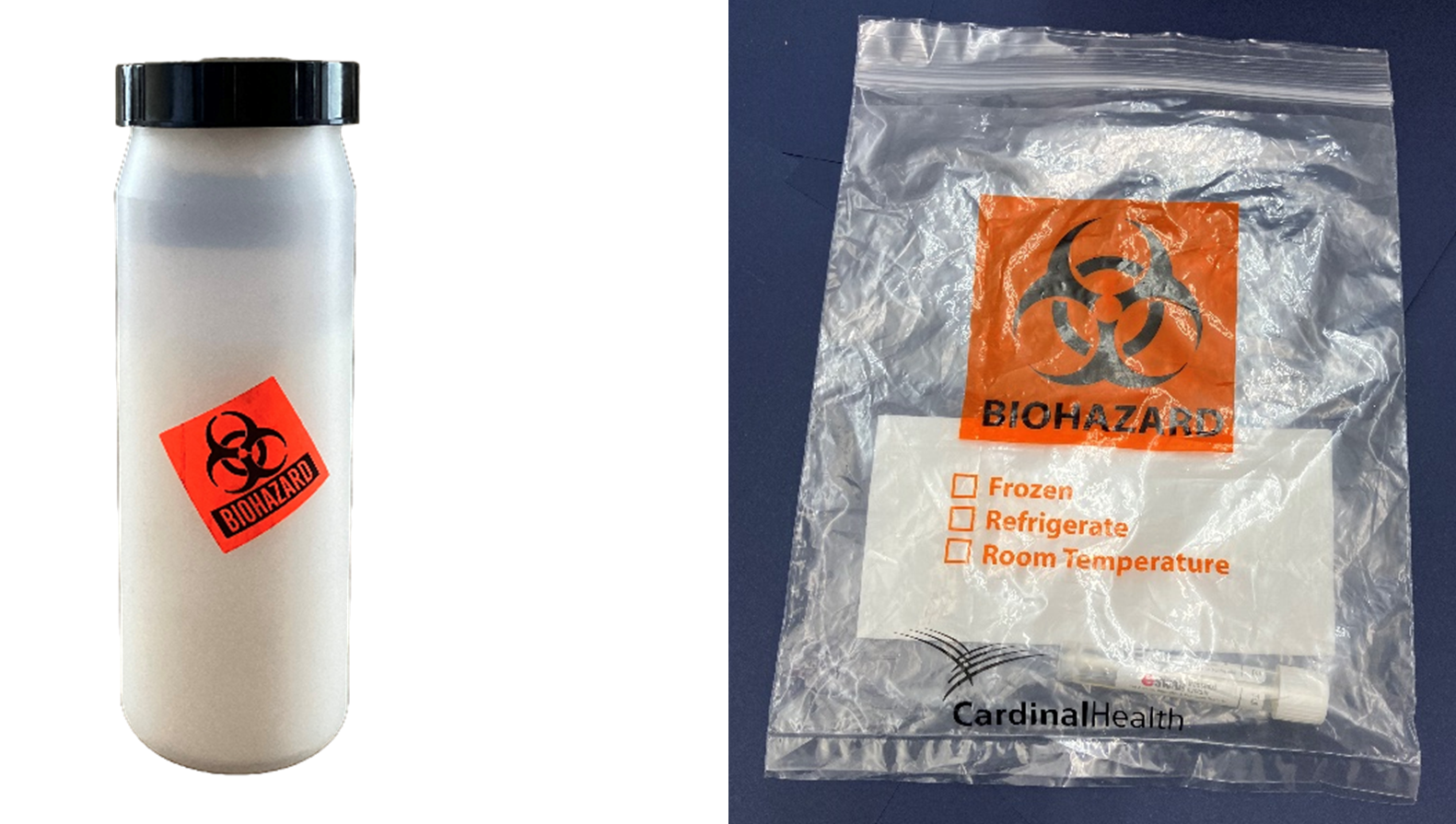
Depending on the specimen, secondary containers may be rigid plastic such as the liner tube at left, or resealable plastic bags, as shown at right. Note the pad of absorbent material in the biohazard bag. The secondary container should be labeled with a biohazard sticker. Image source: DSHS.
Outer Shipping Container (Mailer):
- Must be made of a rigid material that can withstand the knocks and bumps of transit.
- Must fully enclose the primary and secondary receptacles.
- At least one surface must have a minimum area of 3.9 in. by 3.9 in. (100 mm by 100 mm) for appropriate labeling.
- The surface of the outer container should be clearly and durably marked with the required labeling.
- Outer packaging/mailers for shipping infectious substances must be able to withstand being dropped from a height of 1.2 meters (4 feet) without breaking.
- Bare polystyrene boxes, resealable plastic bags, and paper envelopes are not suitable as outer packaging.
Acceptable Outer Containers for Infectious
Biological Substances

L-R: Corrugated fiberboard (cardboard), wood, and insulated containers with
outer fiberboard box.
Unacceptable Outer Containers for Infectious
Biological Substances
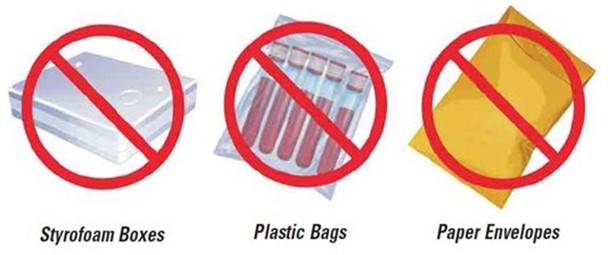
While the majority of specimens the Laboratory receives are Category B Biological and Exempt Substances, occasionally Category A specimens are submitted for testing.
Without exception, all Category A specimens must be shipped using applicable federal and international guidelines.
The regulatory requirements for packing Category A Infectious Substances may be found at 49 CFR § 173.196.
- Patient information and/or submission forms should not be affixed to the outer mailer.
- DSHS Laboratory does not provide mailing supplies for Category A infectious substances.
NOTE: Category A specimens should NEVER be shipped to the Laboratory via the US Postal Service (USPS). The diagram below identifies the parts of a correctly packaged Category A specimen.
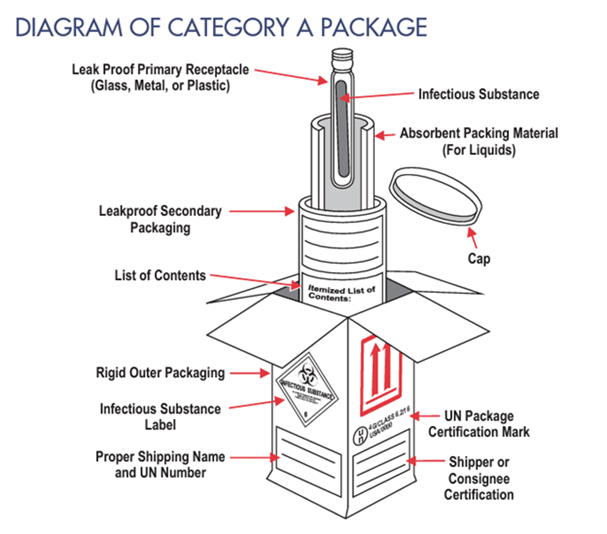
EXAMPLE: Category A packaging for shipping. Image Source: U.S. DoT PHMSA Transporting Infectious Substances Safely. https://www.phmsa.dot.gov/sites/phmsa.dot.gov/files/2020-04/Transporting-Infectious-Substances-Safely.pdf Accessed 6/14/22
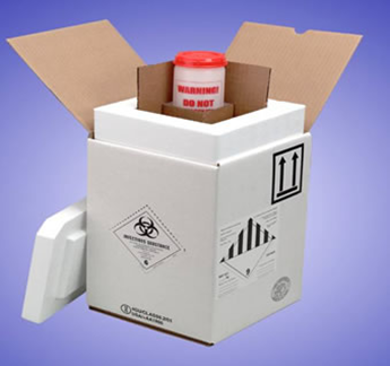
The required packaging and labeling for a Category A infectious substance. Note the infectious substance/ biohazard label, affixed to the outer container. If using dry ice to keep the specimen cool, a dry ice label is also required. Image source: DSHS.
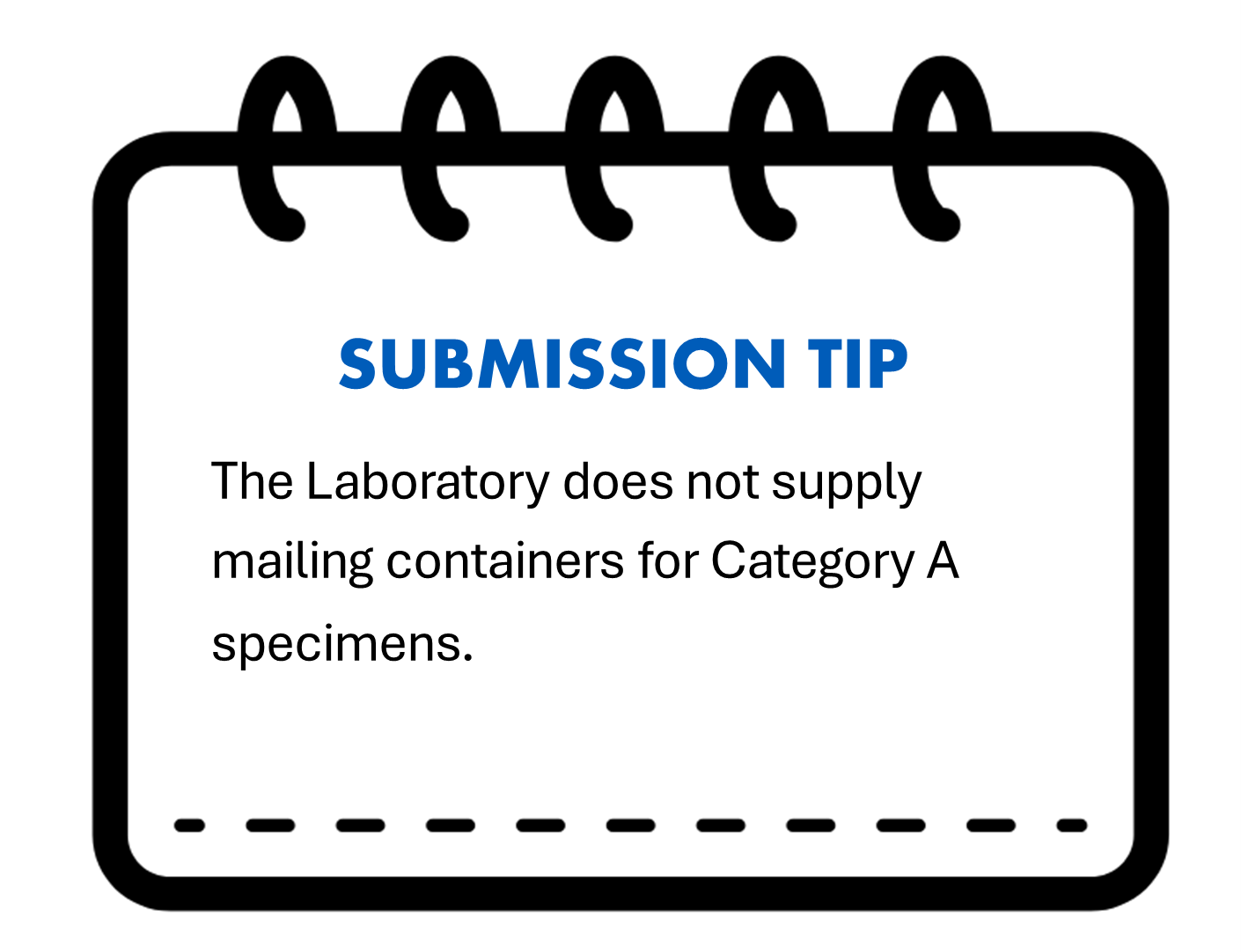
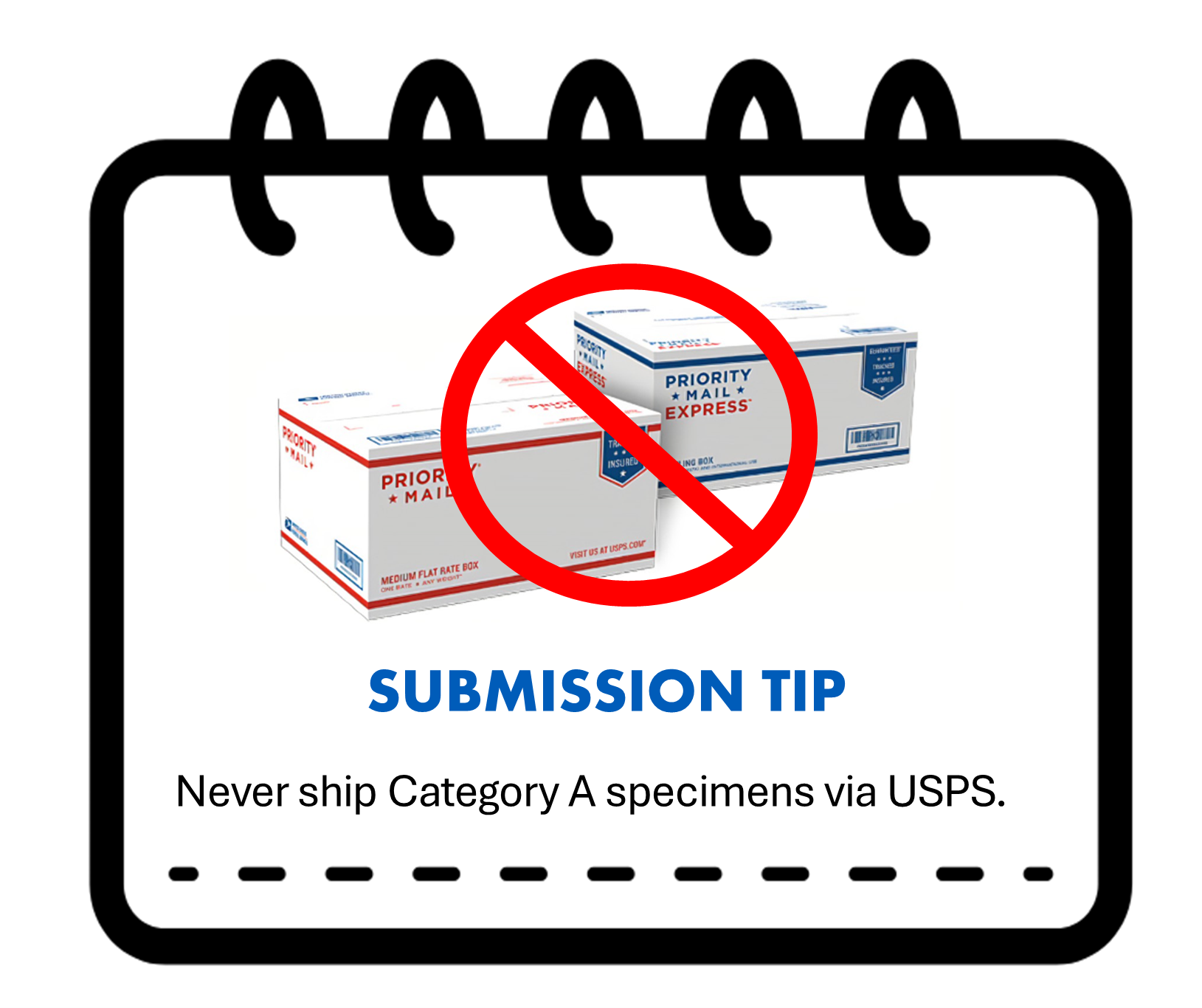
Category B substances must be triple contained. The DSHS Laboratory supplies mailing containers for Category B (UN3373) specimens only to providers who participate in certain DSHS prevention and surveillance programs. Using the provided DSHS containers will ensure compliance with USPS and US DOT requirements.
Please note: Due to recent shortages in the availability of some secondary containers, the Laboratory may on occasion substitute the type of secondary container provided to submitters.
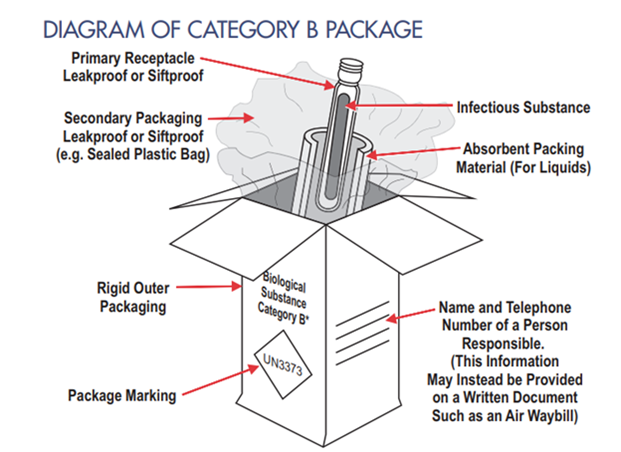
he secondary receptacle for a Category B package may be a rigid canister or a resealable plastic bag. The biohazard label must not be displayed in the outer mailer; it should be affixed to the secondary receptacle, as shown below. Image Source: U.S. DoT PHMSA Transporting Infectious Substances Safely. https://www.phmsa.dot.gov/sites/phmsa.dot.gov/files/2020-04/Transporting-Infectious-Substances-Safely.pdf Accessed 12/17/2024
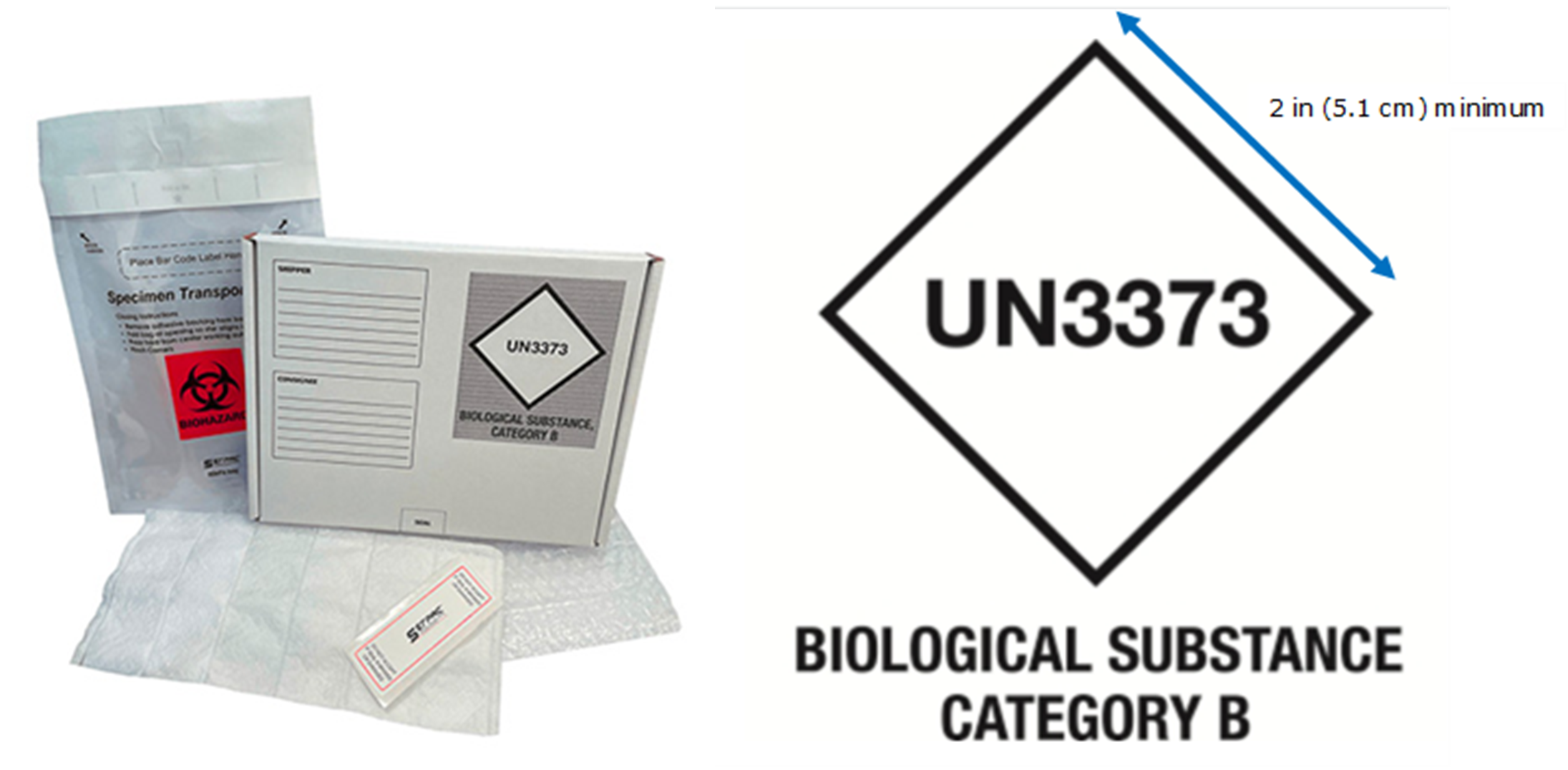
The outer mailer of a Biological Substance Category B, infectious Substance must be labeled with the UN3373 marking. Note the biohazard label is affixed to the secondary receptacle, not the exterior.
Biological Substance, Category B, UN3373 Label Specs: Each side of the diamond must be a minimum of 2 inches (50 mm) long, with a border of at least 2 mm wide. “Biological Substance Category B” and “UN3373” must be a minimum of 6 mm. Image source: DSHS.
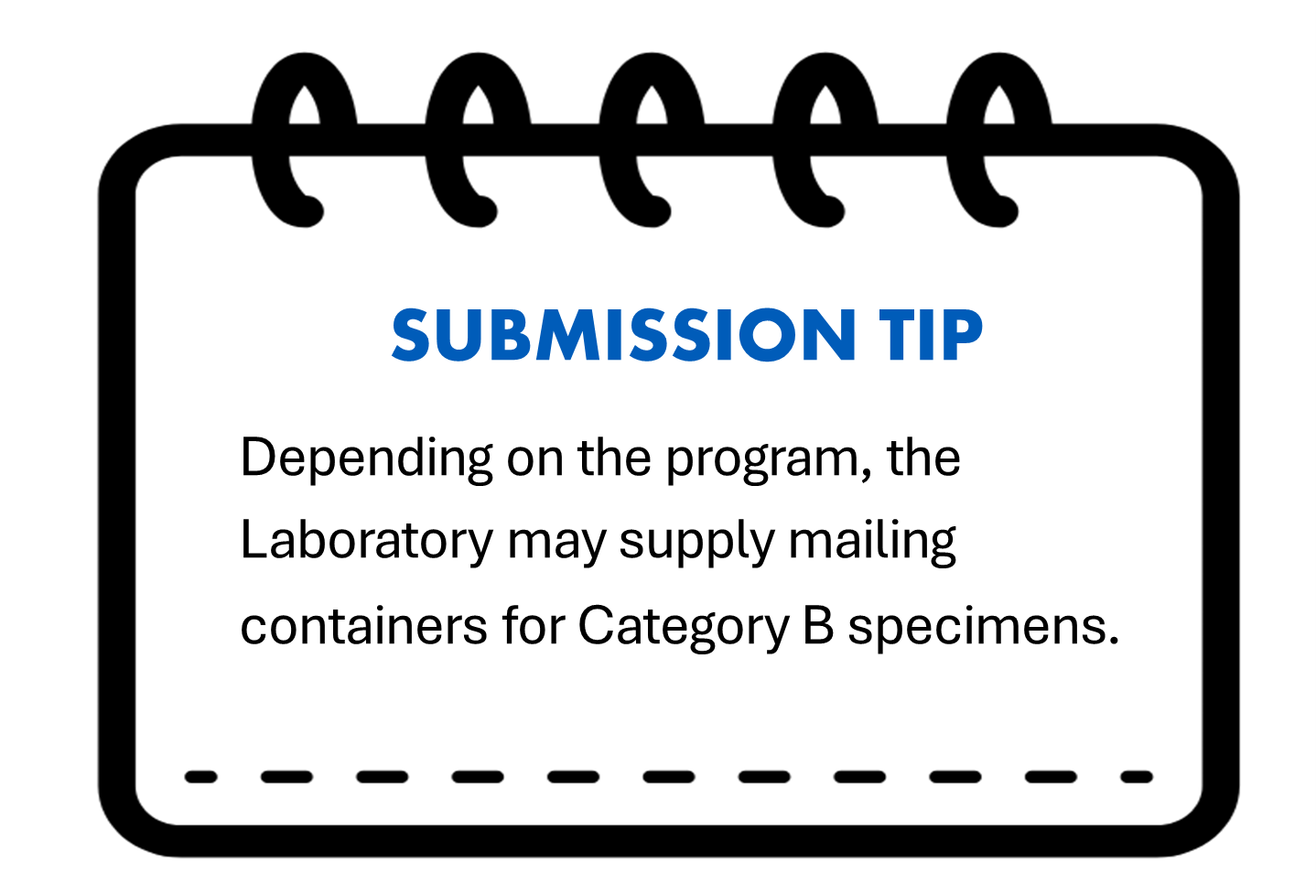
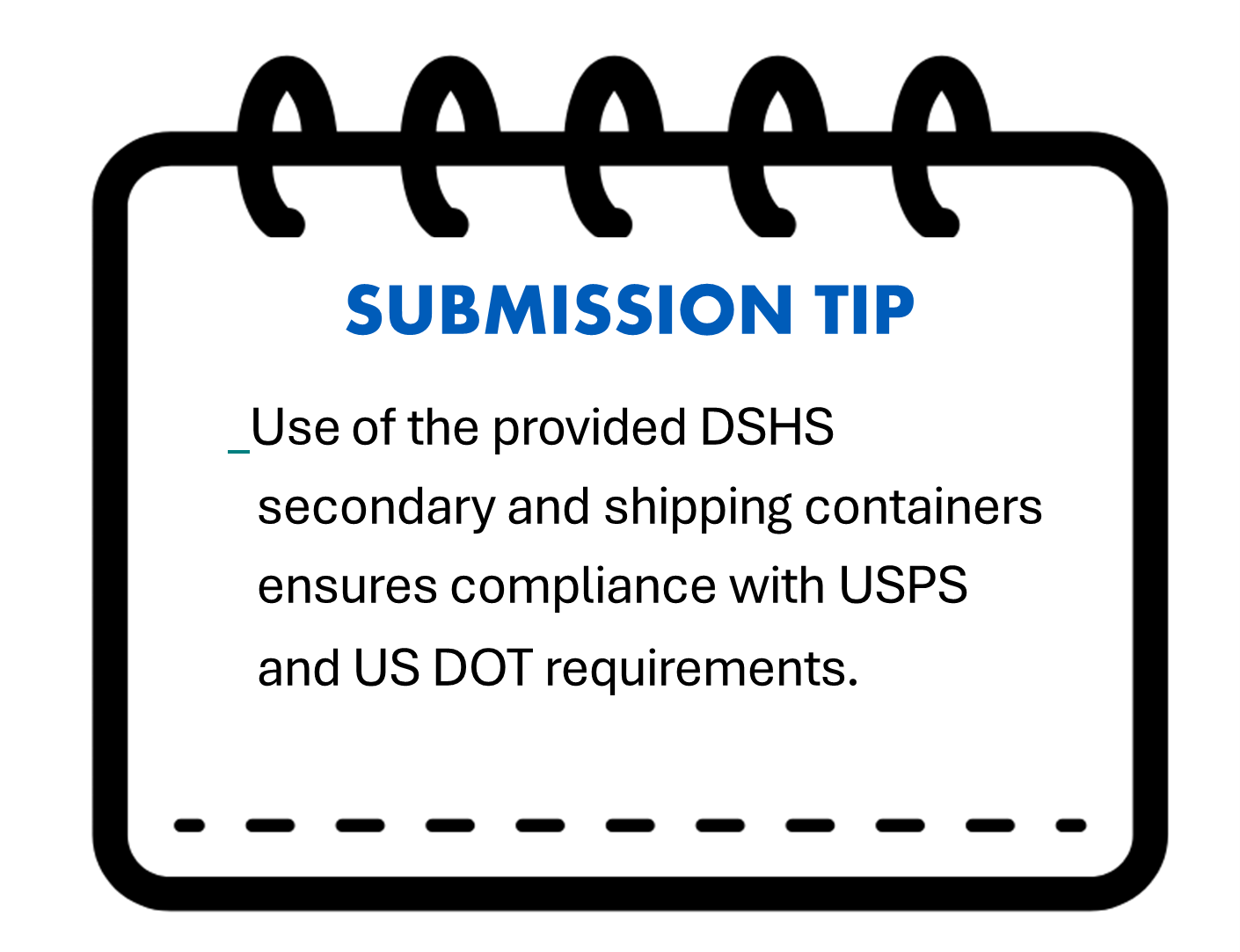
Additional information about the specimen submission requirements for specific tests at the Lab may be found in the DSHS Directory of Laboratory Tests and Specimen Requirements.
To ensure specimens arrive in testable condition, submitters must:
- Label each specimen container with at least two unique patient identifiers; three identifiers are preferred. Specimen identifiers must be identical to the patient identifiers used on the specimen submission form(s).
Acceptable specimen identifiers include, but are not limited to the:
- Patient’s Name
- Patient’s Date of Birth
- Patient’s Medical Record Number
- Specimen Identification Number
- CDC Number
- Unique Random Number
- Medicaid Number
- Newborn Screening Kit Number
Note: Location-based identifiers are NOT acceptable (e.g., hospital room number or street address).
Example of Patient Identifier Agreement

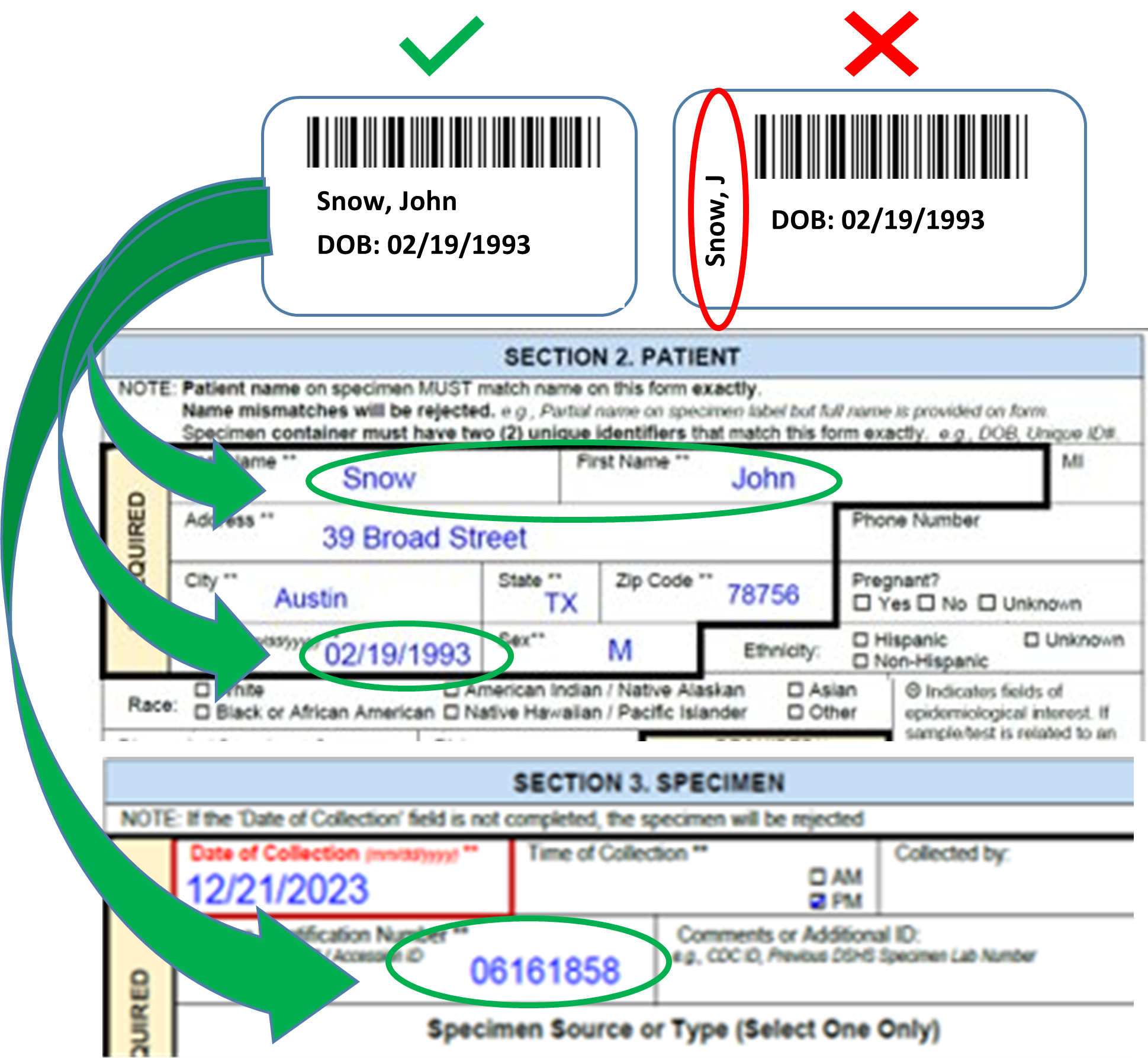
 ACCEPTABLE
ACCEPTABLE
- Every patient identifier on specimen label matches submission form exactly.
 NOT ACCEPTABLE
NOT ACCEPTABLE
- Name shortened and different to form.
- ID Number different to one in form.
- Minimum number of usable identifiers not provided.
- Provide a Separate Specimen Submission Form for Each Specimen in Container Information for multiple specimens should not be added to a submission form; one specimen, one form. Multiple submission forms may be bundled together when multiple specimens are packaged together.
- Complete ALL Required Fields on Specimen Submission Forms
- Patient information on the specimen MUST match the information in the accompanying submission form.
- Use BLOCK LETTERING to complete all required information on the form. Avoid using cursive script.
- Provide payor source information, including the Medicaid number if the patient is Medicaid eligible, or if the submission is a THSteps (EPSDT) specimen.
- Provide the patient’s Name, Date of Birth, Address, the specimen’s Date of Collection, and the ICD Diagnosis Code.
- Provide the ordering physician’s National Provider Identification (NPI) number, when applicable.
- Identify the specimen source and the type of test being requested.
- Include Completed Specimen Submission Form(s) with Specimen(s) If the specimen is being shipped at ambient temperatures, affix the submission form to the outside of its secondary container. If the specimen requires shipping at frozen or chilled temperatures, first place the submission form in a sealable plastic bag to prevent it from getting wet. Then, affix the form to the lid of the insulated box (the insulated box should be shipped within an external fiberboard box.)
- Avoid Attaching Submission Forms to Outer Mailers Patient/specimen information should be attached to the internal, secondary containers only. Patients’ PHI should not be affixed to outer mailers.
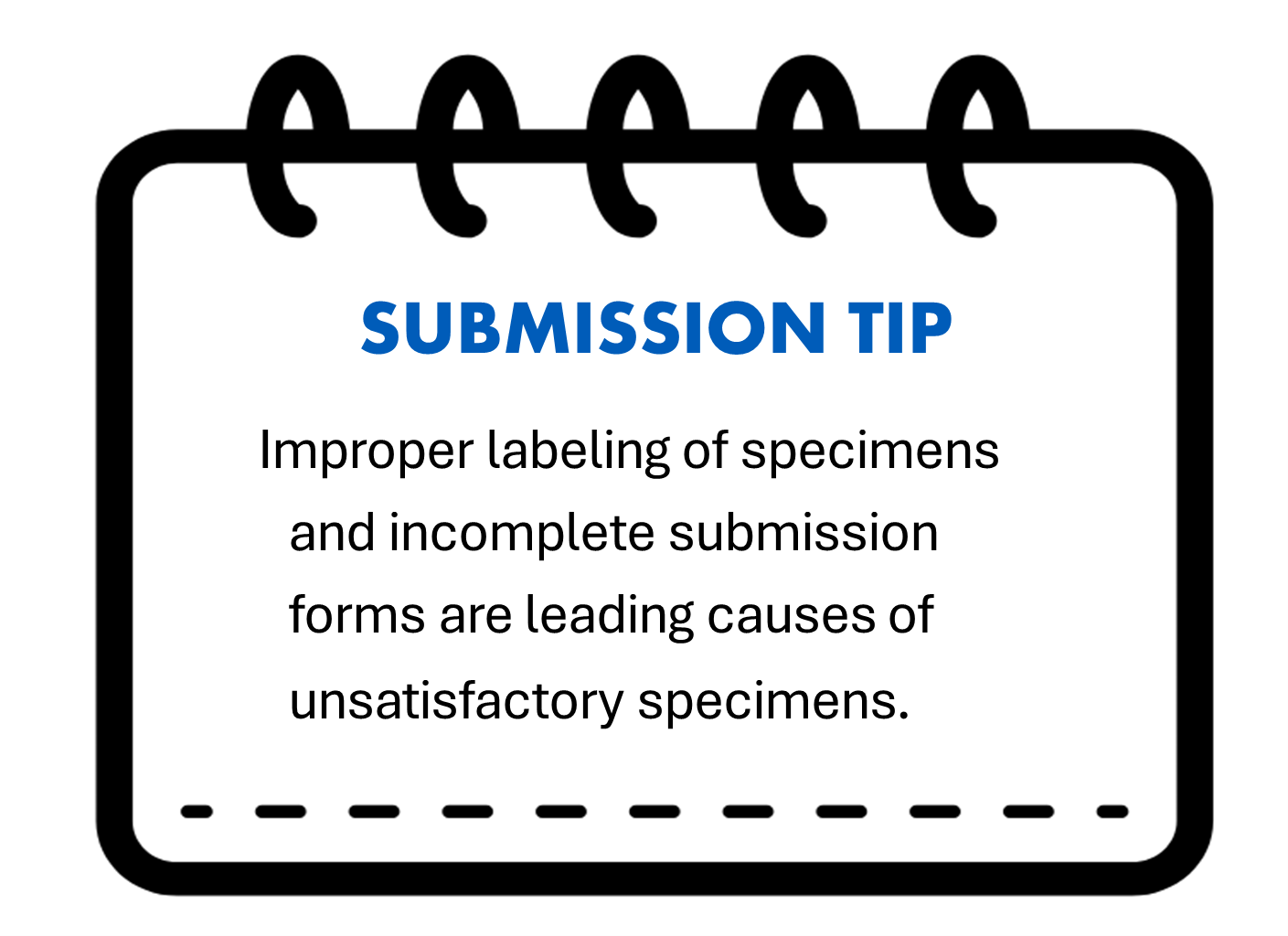
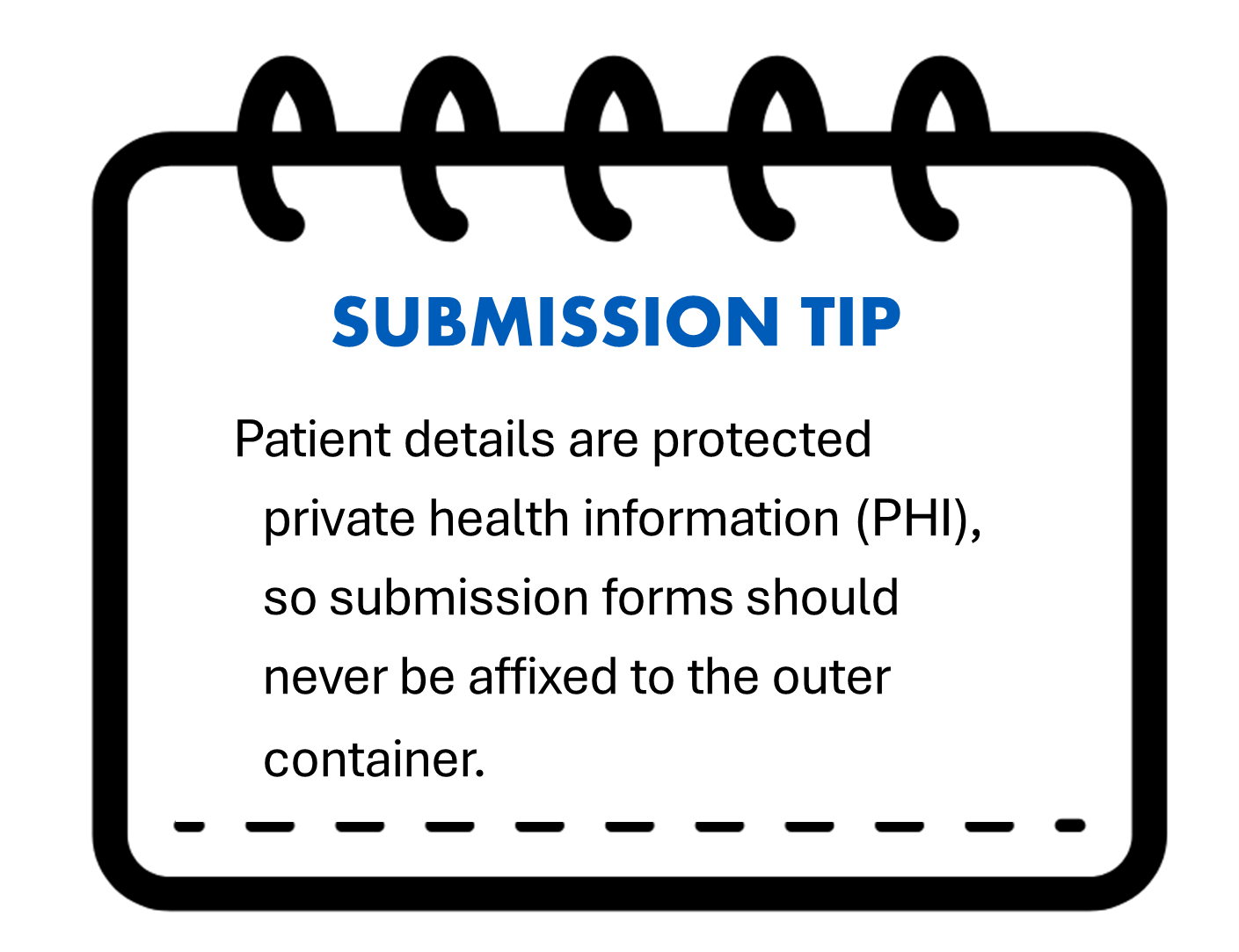
The number of specimen containers, such as blood collection tubes, swabs, or urine or fecal collection containers that break or leak in transit can be reduced or eliminated by using appropriate packaging and following these simple instructions.
If the specimens need to be shipped refrigerated, an insulated external mailer and cold packs/dry ice are required.
| Packing Ambient Specimens for Shipping | |
|---|---|
| Assemble all required package components. | |
 |
Firmly Close Specimen Containers
|
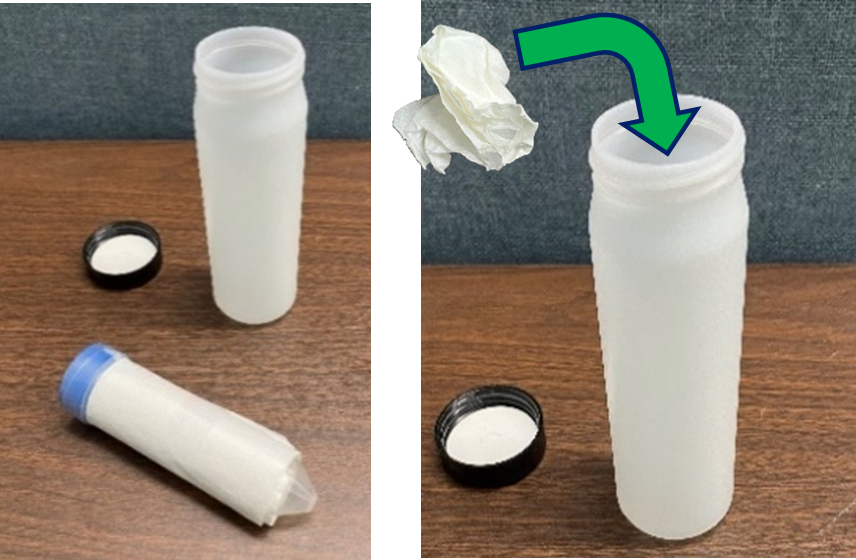 |
Pack With Plenty of Absorbent/Cushioning Material
|
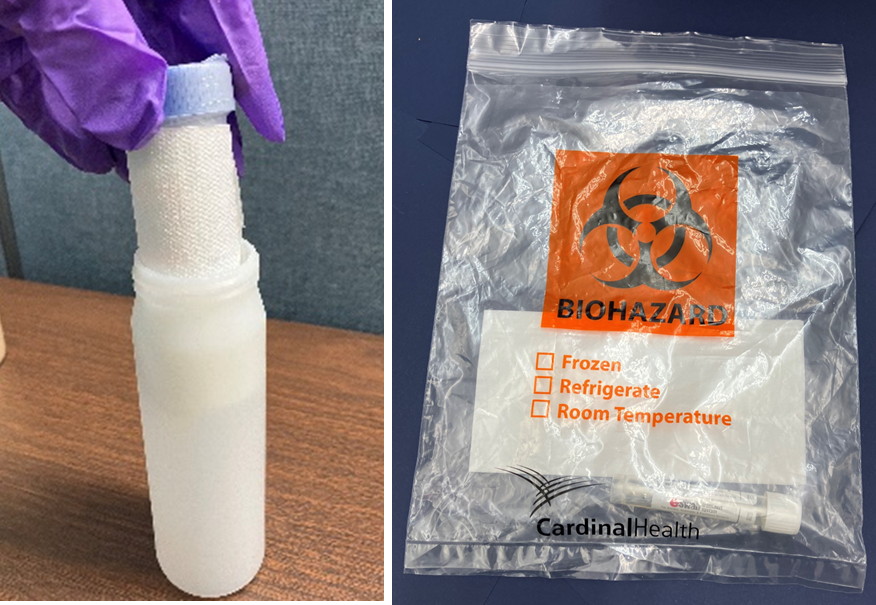 |
|
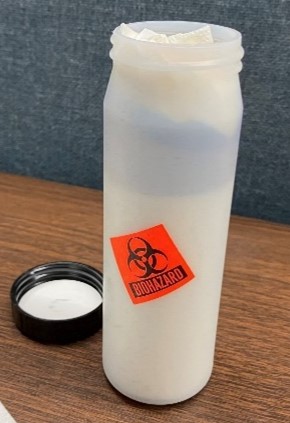 |
|
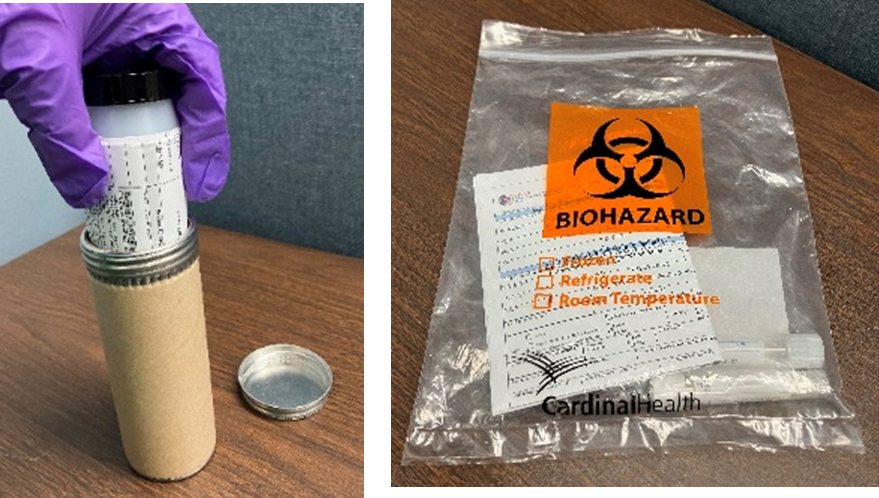 |
|
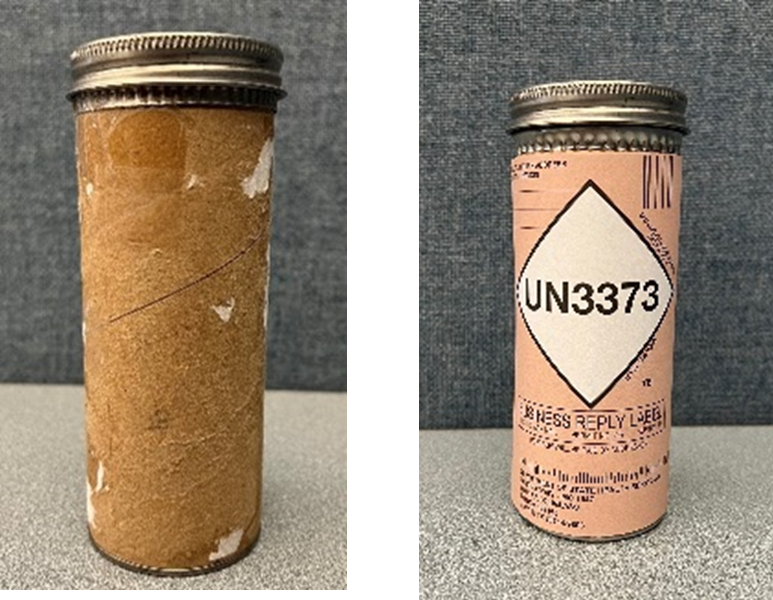 |
|
Note: Properly using shipping containers provided by the DSHS Laboratory will ensure compliance with USPS and DOT requirements.
If using mailers obtained from other sources, they must be suitable/approved for shipping Category B Biological Substances, (UN3373).
Several specimen types, including whole blood, serum, raw stool, and C. auris colonization swabs require cold shipping to the Laboratory. Specimens that must be shipped cold or frozen but that arrive at the Laboratory out of temperature range or at ambient temperature cannot be tested. Additional quick reference DSHS Laboratory job aids on shipping specimens to the Lab are available online here.
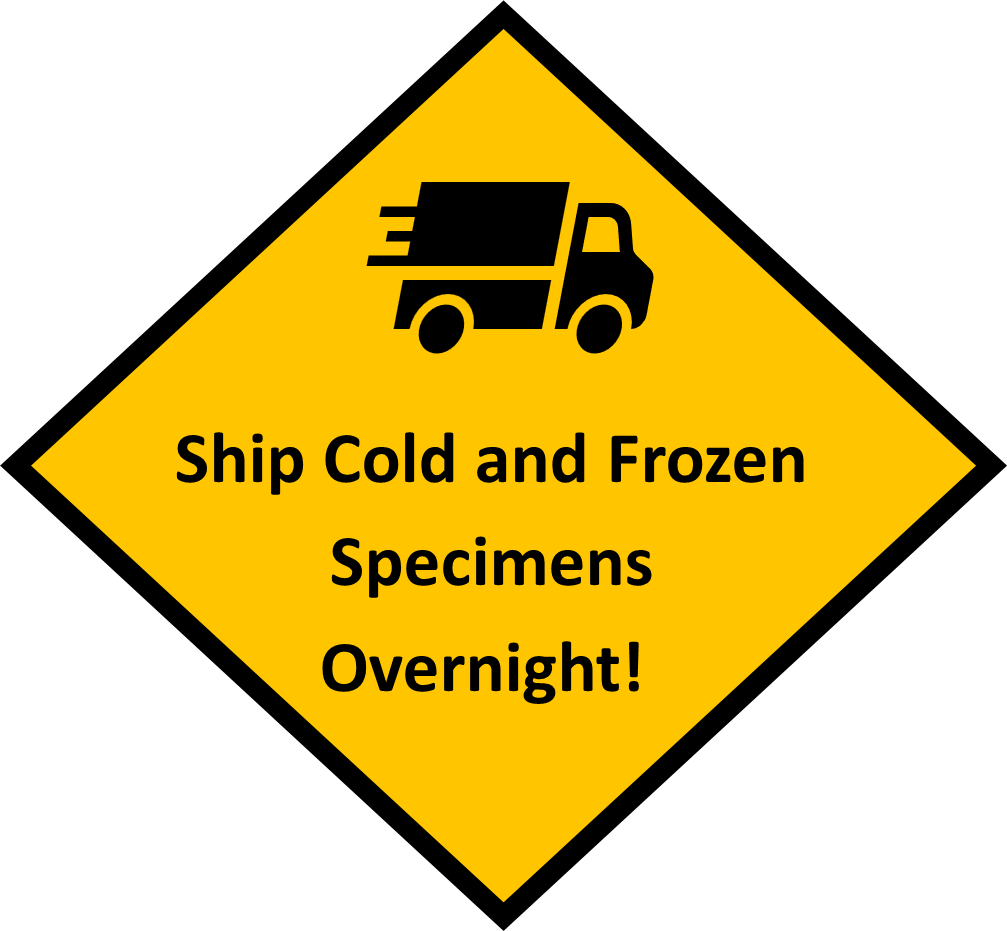
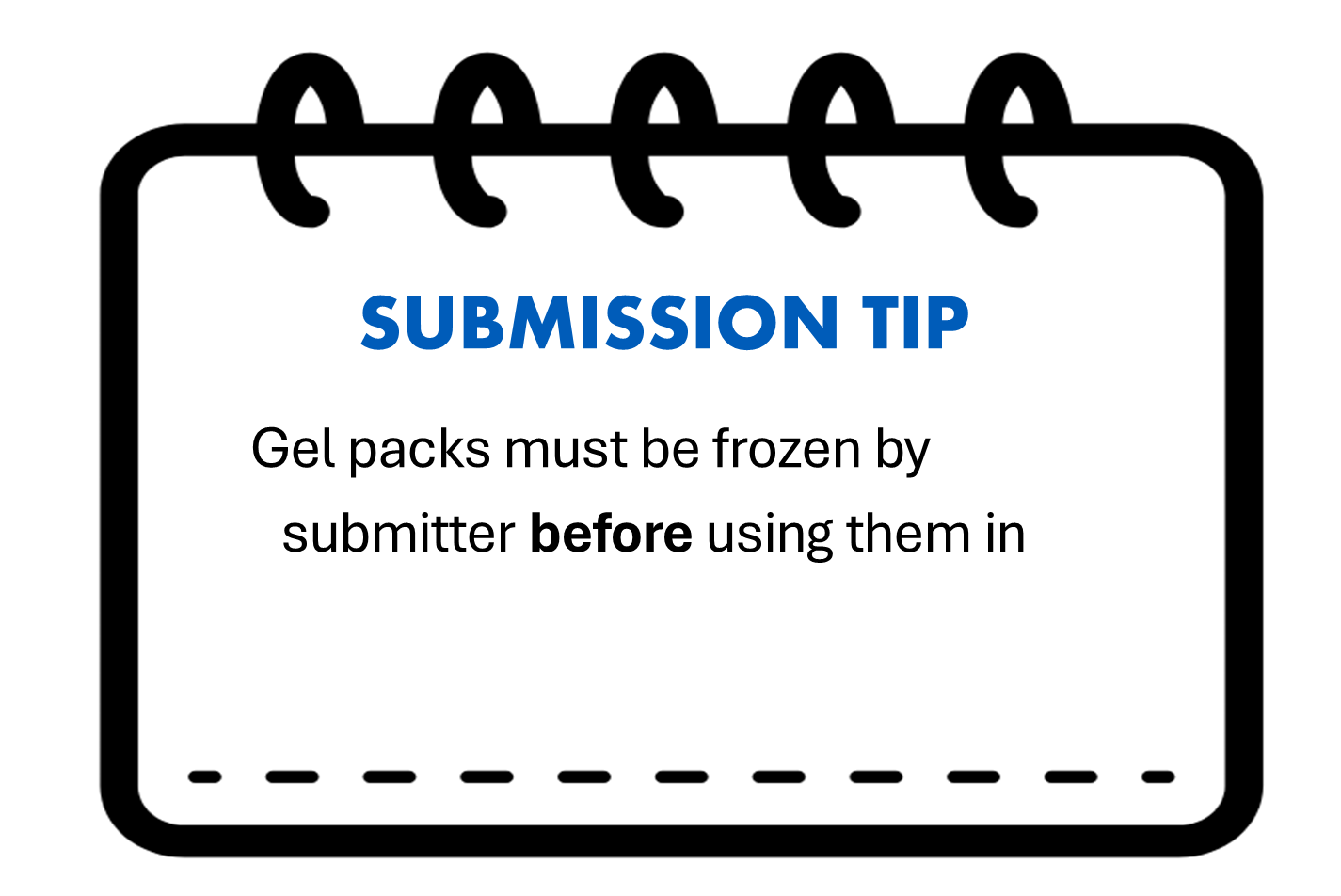
IMPORTANT: If using a courier to ship temperature sensitive specimens to the Laboratory, please follow the courier’s packing and shipping directions.
|
|
| Assemble all required package components. | |
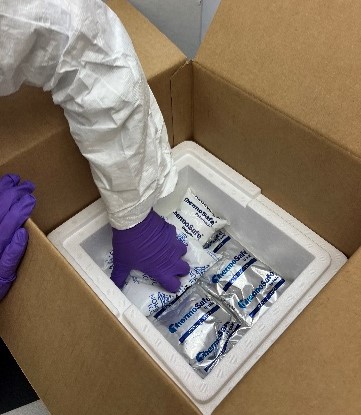 |
Add Frozen Ice Packs to the Insulated Container
|
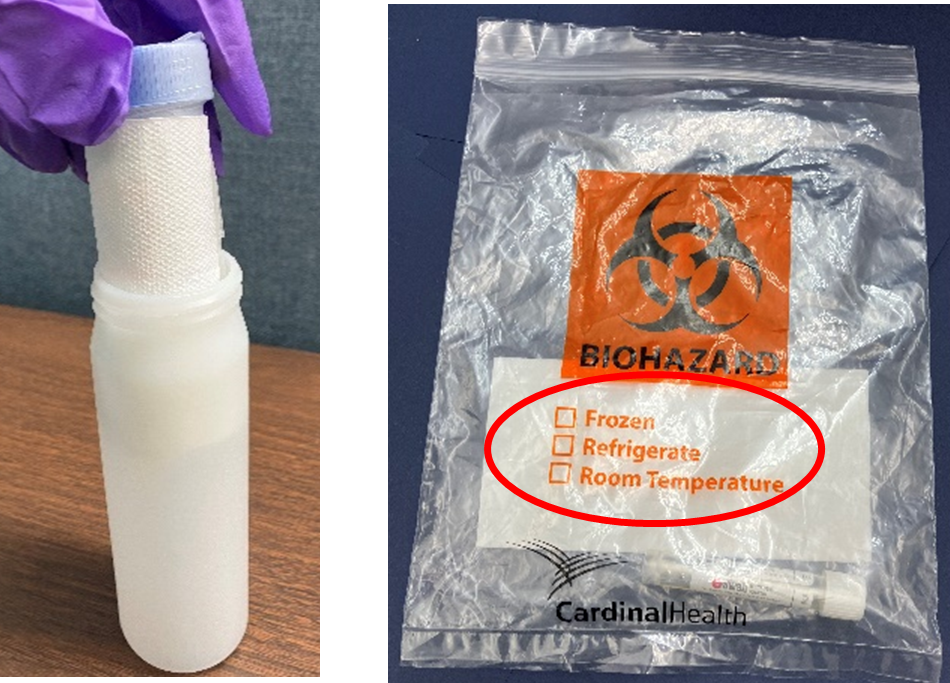 |
Place Specimen in Secondary Container
|
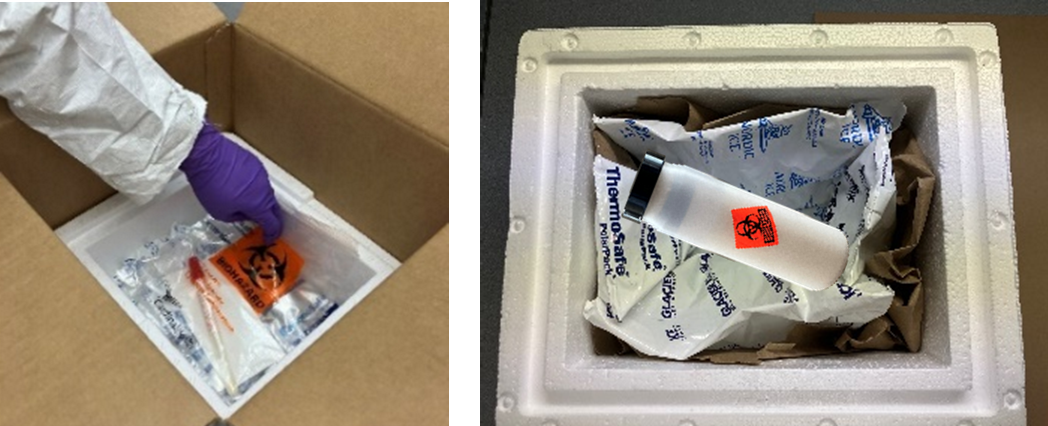 |
Place Specimen(s) in Insulated Container
|
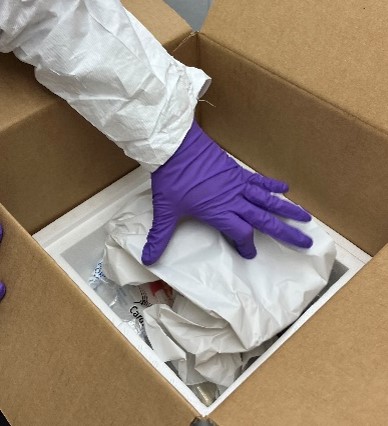 |
Fill Remaining Empty Space with Absorbent Material
|
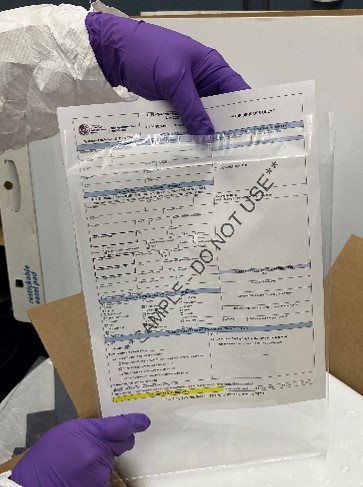 |
Add Submission Form(s) to Shipment
|
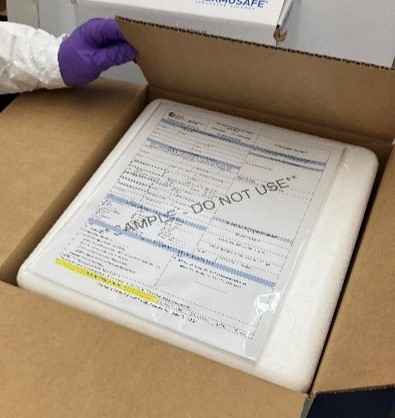 |
|
- Ensure a diamond-shaped UN 3373 label is affixed to the exterior of the fiberboard box when shipping Biological Substance, Category B.
Notes of Shipping Frozen Specimens
Dry ice has a temperature of -78.5°C. Use dry ice when specimen must be shipped frozen.
- Ensure the shipping container used with the dry ice is not airtight.
- Dry ice sublimates from a solid into carbon dioxide (CO2) gas, so it must be shipped in a gas-permeable container.
- Polystyrene coolers allow CO2 to outgas, others may not.
- Dry ice sublimation rate will depend on the density of the polystyrene cooler. The higher the density, the slower the sublimation.
- In general, 5 lbs. of dry ice in a thick polystyrene cooler can take up to 24 hours to sublimate.
- Ensure specimens are frozen before adding to the shipping container.
- Keep dry ice separated from specimens. Direct contact with dry ice may damage the specimens.
- Do not use blocks of dry ice to secure or cushion specimen(s) in the shipping container as it will sublimate and specimens will become unsecured.
- Use enough dry ice; if it is entirely sublimated upon delivery, specimen will be logged as being out of temperature range.
- Dry ice must be declared on paperwork for shipping company.
Always follow specific shipping instructions from the Laboratory, DSHS epidemiologist, and/or protocol.
- Dry ice is considered a “dangerous good”. If shipping with dry ice:
- Use less than 5 lbs (2.25 Kg) per shipment.
- Mark the blank box of the air bill and write “dry ice” in its Special Instructions section.
- Attach a diamond-shaped dry ice label on the package with the number “9” and “UN1845” on it. The dry ice label must include the mass of dry ice used in the container in kilograms.
- Complete all required sections of the air bill, place it inside the sleeve, and then attach it to the top of the sealed fiberboard box.
- Ensure the insulated container is not airtight, otherwise it could explode as the dry ice sublimates!
Specimen Packing and Shipping Questions?
Call the Specimen Acquisition Branch at 512-776-7598.
Tips on Beating the Texas Heat
Every summer, many specimens that must be shipped frozen or refrigerated arrive at the DSHS Laboratory at ambient temperatures. These specimens are unsuitable for testing and must be rejected.
Generally, courier and shipping service vehicles that transport specimens to the Laboratory are not refrigerated. Even on a moderately hot Texas summer day of 35°C (95°F), the internal temperature of a vehicle can reach 54°C (130°F) within 30 minutes. Therefore, submitters must be mindful of the challenge that elevated summer temperatures pose to the quality of their specimens. The following tips can help with maintaining the internal temperature of cold and frozen shipments.
Pack refrigerated specimens with multiple frozen gel packs.
- Gel packs must be frozen before using.
- One frozen pack is not enough.
- Ship refrigerated specimens overnight.
Pack frozen specimens with up to 5 lbs. of dry ice.
- Do not use dry ice blocks to secure specimens in place as the ice will sublimate and specimens will become unsecured.
- Ensure insulated container being used will allow dry ice to outgas.
- Ship frozen specimens overnight.
Remove empty space in shipping container.
- Maximize insulation by packing any empty space around specimens with absorbent packing material.
- Also serves as additional cushioning for specimens.
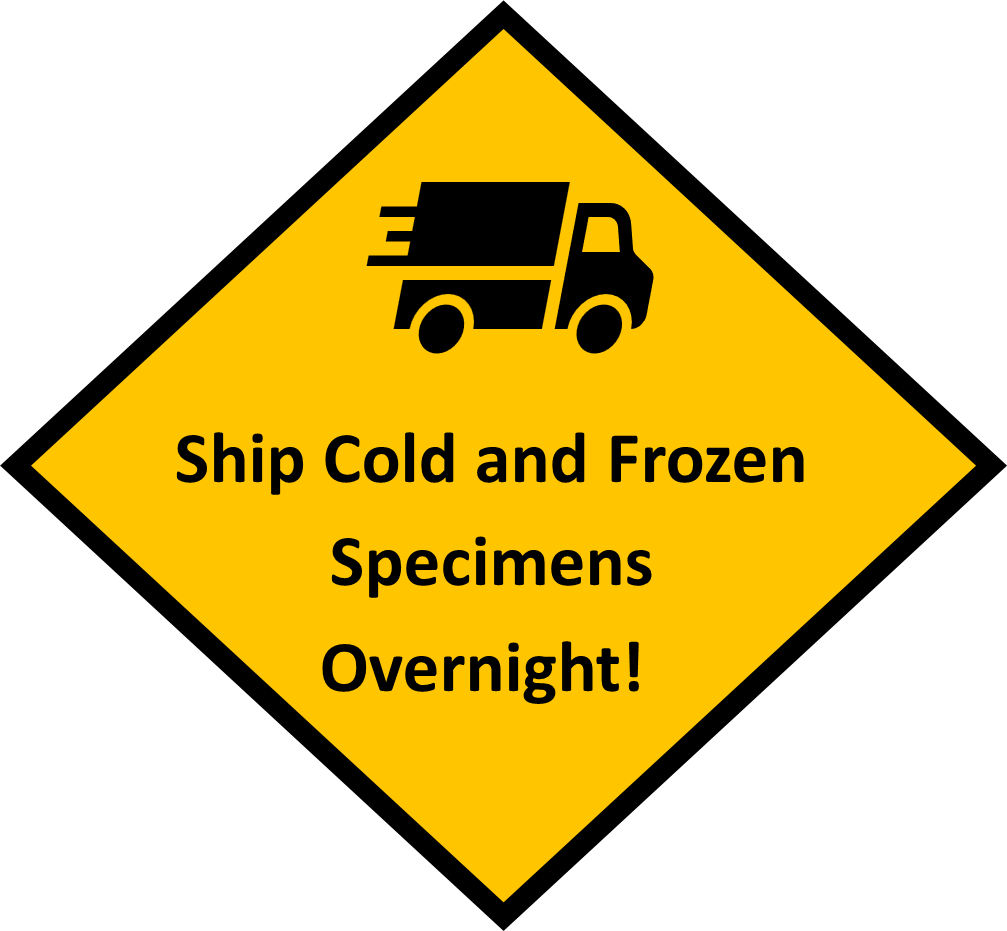
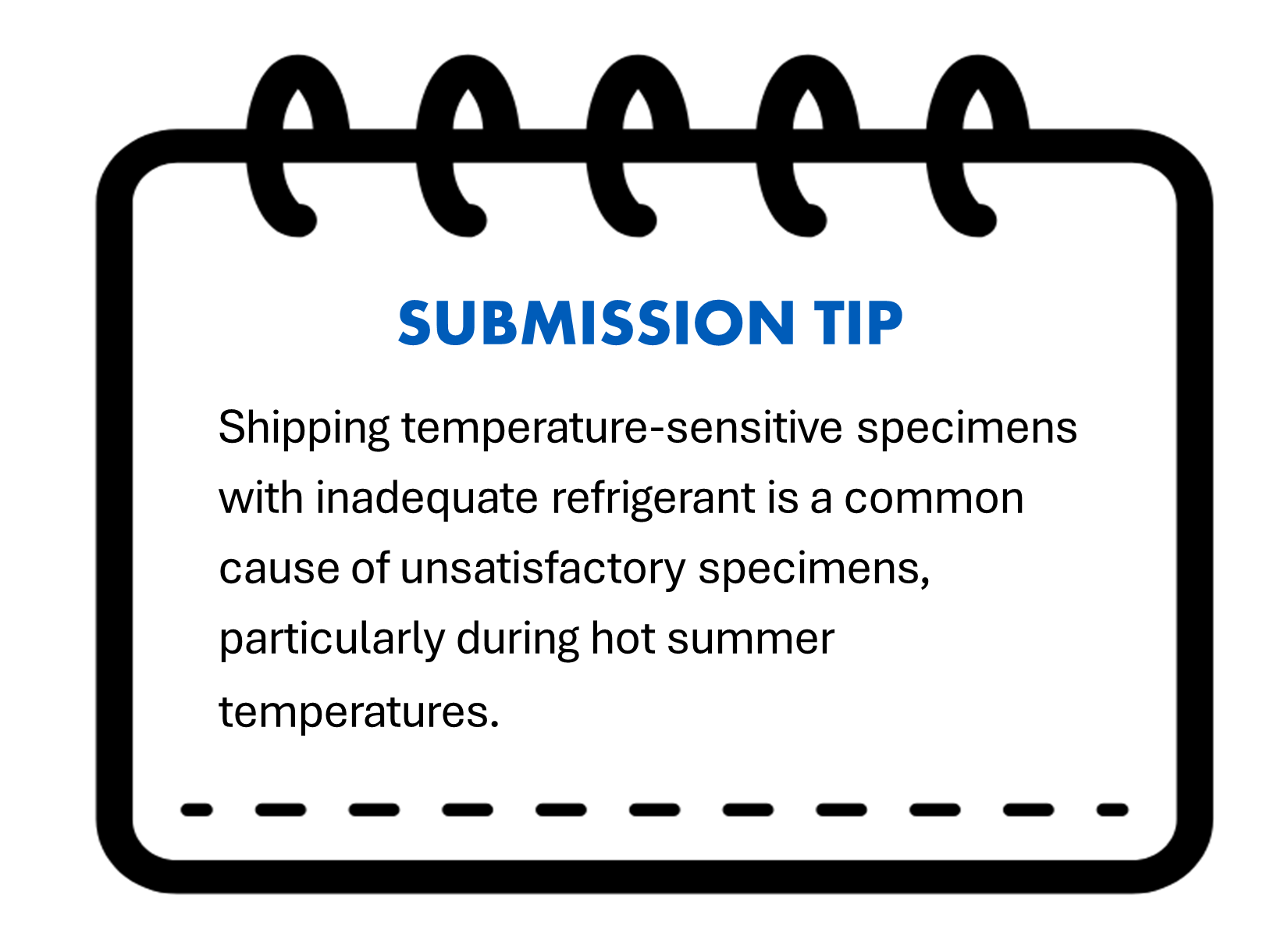
Serum must be stored and shipped cold at 2°C–8°C if testing will occur within two days of collection. Store and ship serum frozen at -20°C on dry ice if testing will occur more than two days after collection.
Prepare for the potential for extremely high temperatures during Texas summers by packing refrigerated specimens with multiple frozen ice packs or plenty of dry ice. Please note:
- Never freeze whole blood specimens or serum separator tubes.
- Pack specimens in compliance with their classification.
- To prevent hemolysis in whole blood specimens, pack them with shock-absorbing material to minimize the results of rough handling.
Submitting Arbovirus Surveillance Program Specimens (Live Mosquitoes)
The Laboratory requires live mosquitoes for arbovirus testing. Live mosquitoes should be shipped to the Laboratory in the provided collection cartons. The cartons are made from pint-sized, plastic containers with lids especially prepared for proper airflow. A corked hole is located on the side of the container.
Mosquitoes are sensitive to high temperatures and low humidity so several moistened paper towels must be added to the shipping container to maintain high humidity. Frozen gel packs or plastic containers of frozen water should also be added to the shippers to maintain low temperatures.
Do not use dry ice to keep the specimen cool as it sublimates to carbon dioxide gas which will asphyxiate the mosquitoes.
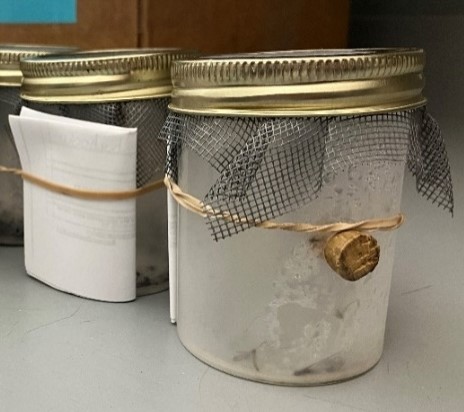
Mosquito collection cartons. Note the rubber bands securing submission forms to the containers. Photo © DSHS 2024.
Specimens should be submitted to the Laboratory as soon as possible after collection (prefer same day) since mortality increases with prolonged captivity. Excessive handling of specimen mosquitoes is also discouraged as it will increase mortality. A G-14 Mosquito Submission form must accompany each specimen container. Attach the form to the container with a rubber band. Shipping boxes are reusable and may be used repeatedly.
For more details, visit DSHS Arbovirus Field Surveillance Techniques webpage, and the submission forms page to download a copy of the G-14 mosquito submission form.
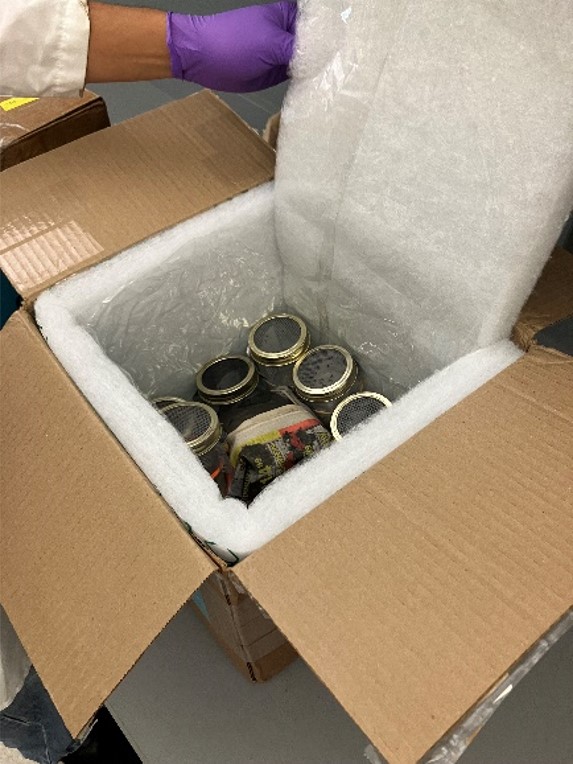
Several mosquito collection cartons packed inside a padded shipping container. Photo © DSHS 2024.
Important Considerations for Submissions to the Laboratory via USPS and Paid Courier Services
Regardless of which carrier a provider/submitter chooses to use (DHL, FedEx, LSO-LoneStar Overnight, UPS, USPS, etc.), all specimens must be packaged carefully and adequately to avoid leaks or breaks. Submitters are responsible for the proper packaging, labeling, and shipping of their specimens. The submitter is legally responsible for compliance with the shipping rules.
The Laboratory is not responsible for improperly submitted specimens. The Laboratory also cannot endorse or recommend a specific shipping service for submitters.
- Many commercial carriers do not accept biological specimens for transport. Some couriers require submitters to obtain pre-approval before shipping dangerous goods (which includes both Category A, Infectious Substances and Category B Biological Substances).
- Submitters are responsible for identifying before shipping whether biological specimens are prohibited by their chosen courier service.
- Category A Infectious Substances should never be shipped via USPS! More detailed requirements for the submission of biological specimens, including Biological Substance, Category B, UN3373 through the USPS can be found at USPS.com.
- Package specimens carefully. Every specimen in a secondary container will be considered broken even if just one specimen in the secondary container breaks or spills during shipment. Always practice care and due diligence in properly securing packages for transport.
- Certain couriers can ship only ambient temperature specimens. It is the responsibility of the submitter to determine before shipping whether their chosen courier ships temperature-sensitive specimens.
- Ship cold and frozen specimens overnight. The sooner temperature sensitive specimens can arrive at the Lab, the better.
- Specimens are accepted during regular business hours only.* All specimens transported by courier are accepted Monday–Friday 8:00 a.m.–5:00 p.m. Routine testing of specimens delivered after 3:00 p.m. on Fridays will be carried out the following Monday.
- Shipping overnight for arrival after closing hours, on weekends, or on holidays is discouraged. Only under exceptional circumstances the Laboratory can accept deliveries outside of regular business hours. Prior approval is required for testing outside regular business hours.
- Avoid shipping for weekend arrival at the Laboratory. If a specimen is shipped for a weekend arrival, transport/courier services will hold onto it for delivery on Monday or the next regular workday, which may cause some specimens, particularly refrigerated ones, to become unsatisfactory for testing.
- Call your overnight courier if a specimen pick-up is needed. If your chosen overnight carrier does not make regular pick-ups at your facility, you should call the carrier and let them know you need a pick-up.
- Temperature-sensitive specimens should be shipped with enough coolant to keep them cold for up to 48 hours. Ensure cold specimens are packed with enough frozen gel packs to keep them cold until delivery to the Lab.
- Emergency Saturday testing of rabies specimens is available only with prior approval. In exceptional circumstances and due to public health concerns, emergency weekend testing of rabies specimens can be carried out. Emergency testing requirements can be found on the Laboratory’s rabies testing webpage.

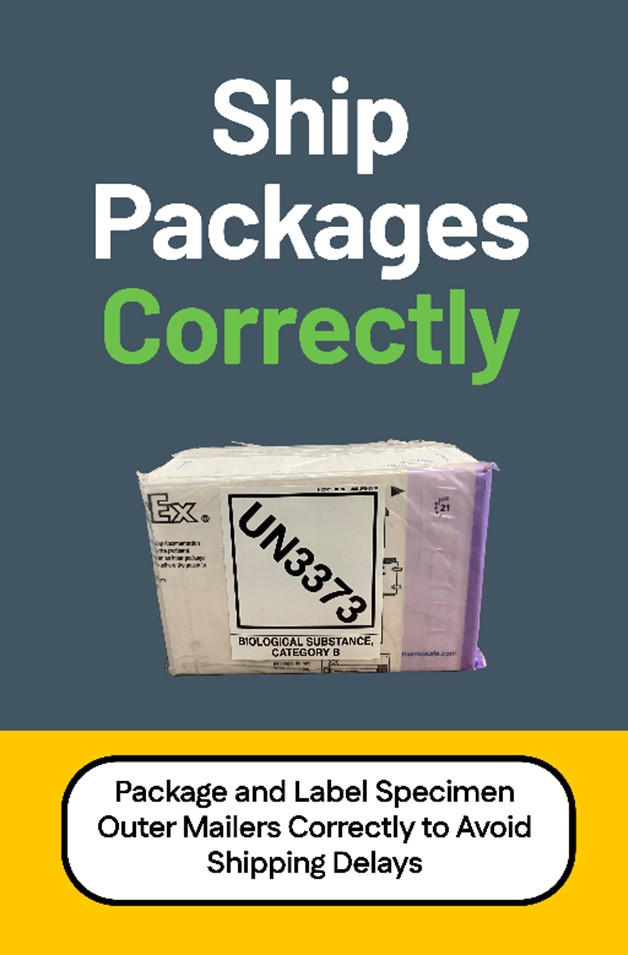
The Laboratory provides specimen mailing containers and labels to healthcare providers and public health laboratories upon request. These mailing containers and labels meet current US DOT and USPS regulations for shipping Biological Substance, Category B, UN3373. They are the property of the State of Texas and should be used only for shipping specimens to the Laboratory.
Obtain order forms for Laboratory mailing containers and supplies here. You may also call the Container Preparation Group at 512-776-7661 or
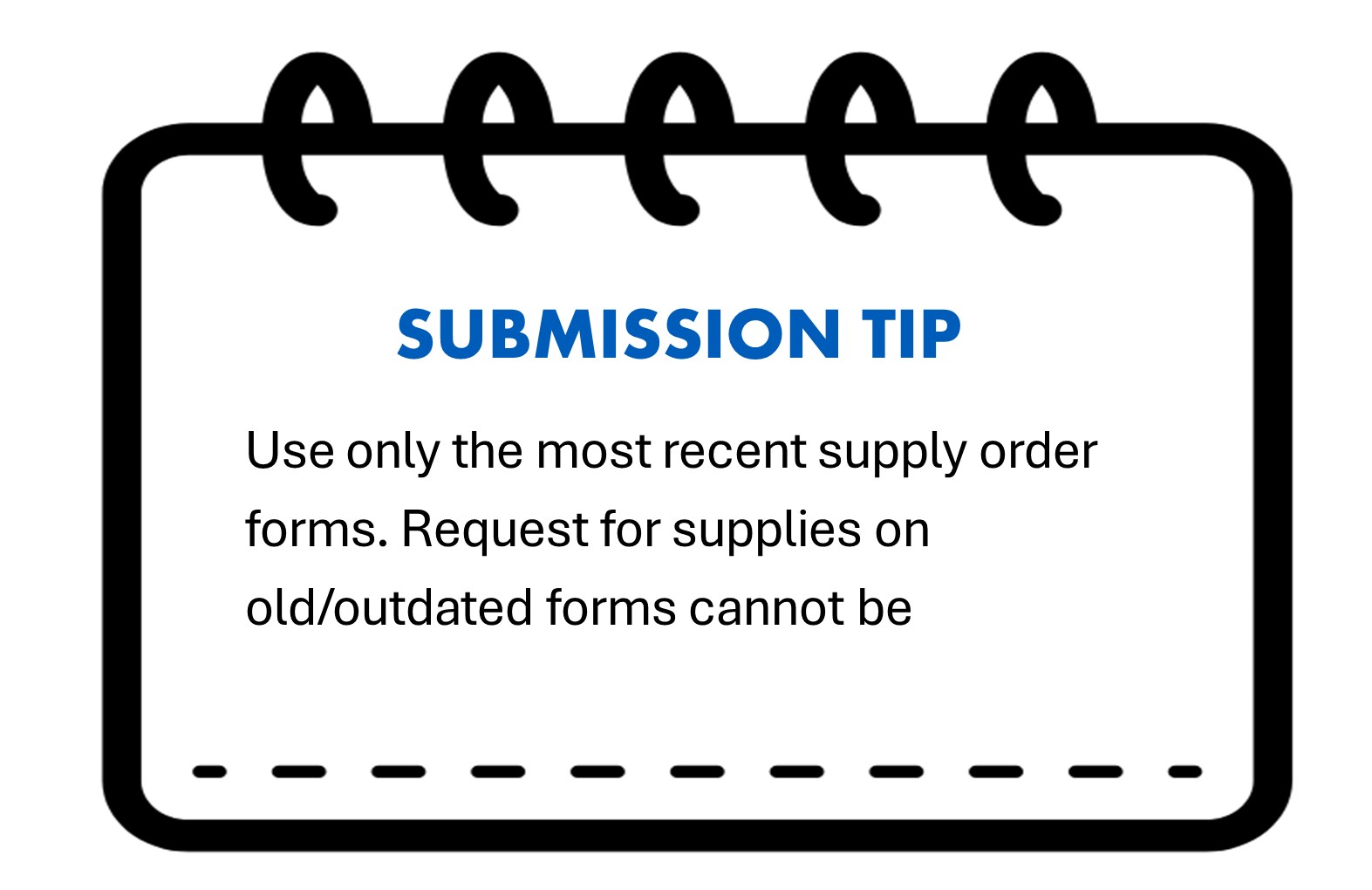
email ContainerPrepGroup@dshs.texas.gov to order supplies to place an order. The container prep group recommends submitters order a two-month supply of containers/supplies. Orders may be faxed to 512-776-7672. Requests will be fulfilled and shipped within five business days of receipt of order.
- Questions about setting up an account to receive supplies from the Laboratory may be directed to the Laboratory Reporting Group at LabInfo@dshs.texas.gov, or call 512-776-7578.
- Questions about the suitability of specimen shipping containers may be directed to the Container Preparation Group at 512-776-7661.
Mosquito/Arbovirus Surveillance Shipping Supplies
The Laboratory provides both collection containers and shipping boxes for mosquito testing for arbovirus surveillance purposes. Careful handling and shipping of live mosquito specimens is essential for testing purposes. Mosquito shipping boxes are reusable and can be reused multiple times. Submitters will need to provide refrigerants such as cold packs to keep the specimens cool. Refer to Arbovirus Surveillance Program pages for further details on preparing specimens for submission.
Things to Note in Obtaining Shipping Supplies from the DSHS Laboratory
- Submitters need to have an up-to-date submitter ID number and account with the Laboratory to order supplies. Refer to the Guidance section Specimen Submission Process: An Overview, for more details on how to obtain a submitter ID number.
- The Laboratory supplies mailing containers for Exempt Specimens and Biological Substance, Category B specimens only.
- Use of the DSHS-provided mailing containers will ensure compliance with USPS and DOT requirements.
- Depending on the specimen type, some shipping materials, particularly secondary mailing containers and outer mailers may be reusable. Please confirm the ability to reuse containers by contacting the Specimen Acquisition group at 512-776-7598.
- While the Laboratory accepts certain hazardous infectious specimens (Infectious Substance, Category A) for testing, the Laboratory does not supply the special mailing containers required for shipping Category A Infectious substances.
- Use only the most recent version of supply order forms when ordering supplies. Orders received on old forms cannot be processed.
- Specimens are received at the Laboratory during regular business hours: Monday–Friday, 8:00 a.m.–5:00 p.m.
- Saturday delivery of rabies specimens (before 8:00 a.m.) for same-day testing is available in emergencies only. Rabies lab staff must first be notified about the submission by phone, email, or the Updated Electronic Rabies Specimen Submission Notification Form.
Toll-free Rabies Notification Number: 1-800-252-8163
For Overnight/Courier Shipping (UPS, FedEx, etc.):
Texas Department of State Health Services
Public Health Laboratory Division
1100 W. 49th Street
Austin, TX 78756-3199
For USPS Regular and Priority Mail (Category B Biological Substances and Exempt Specimens Only):
Texas Department of State Health Services
Public Health Laboratory Division, MC 1947
PO Box 149341
Austin, TX 78714-9341
- For specimen shipping questions, call the Specimen Acquisition group at (512) 776-7598.
- For other mailing and shipping questions, call the Container Preparation Group at 512-776-7661, or email ContainerPrepGroup@dshs.texas.gov.
 Packing Cold and Frozen Specimens for Shipping
Packing Cold and Frozen Specimens for Shipping